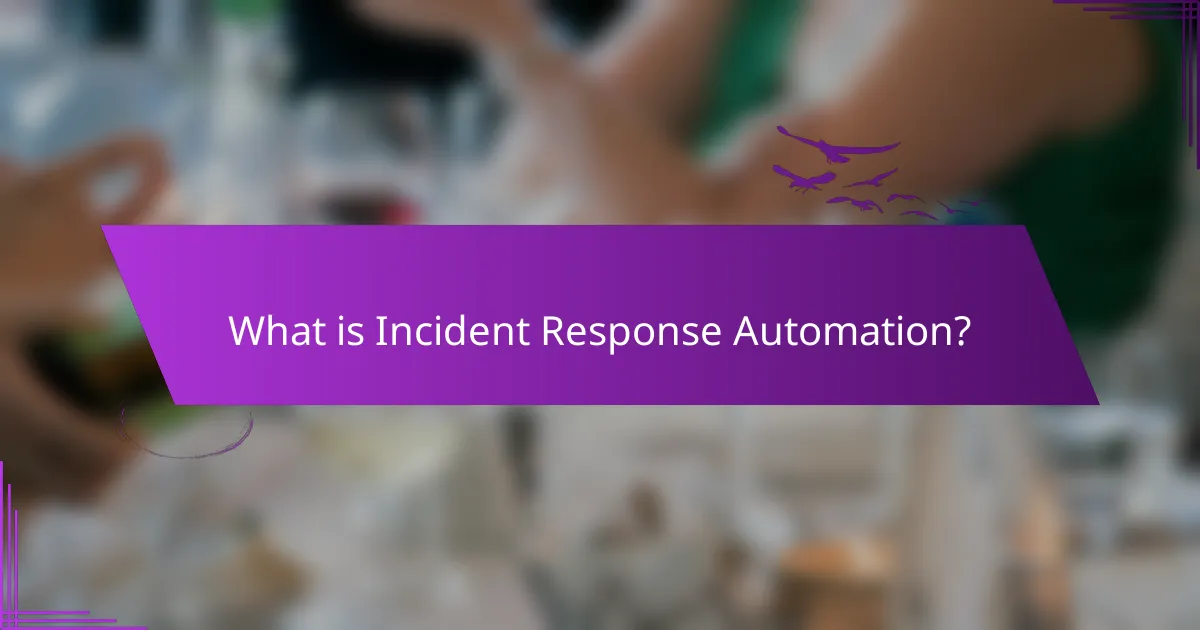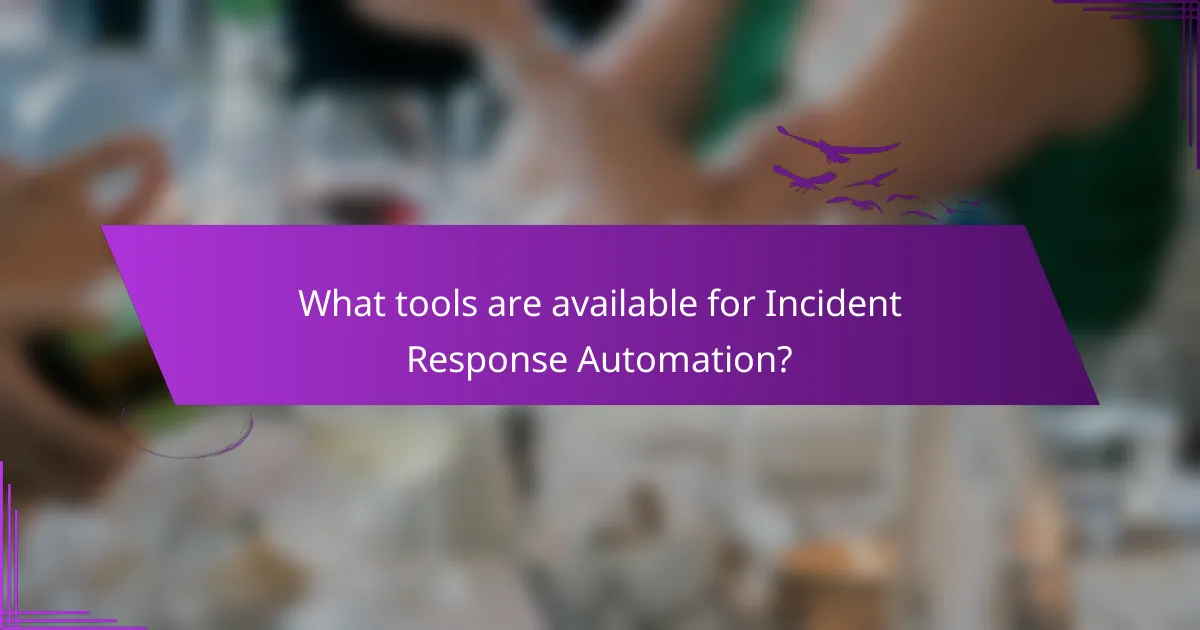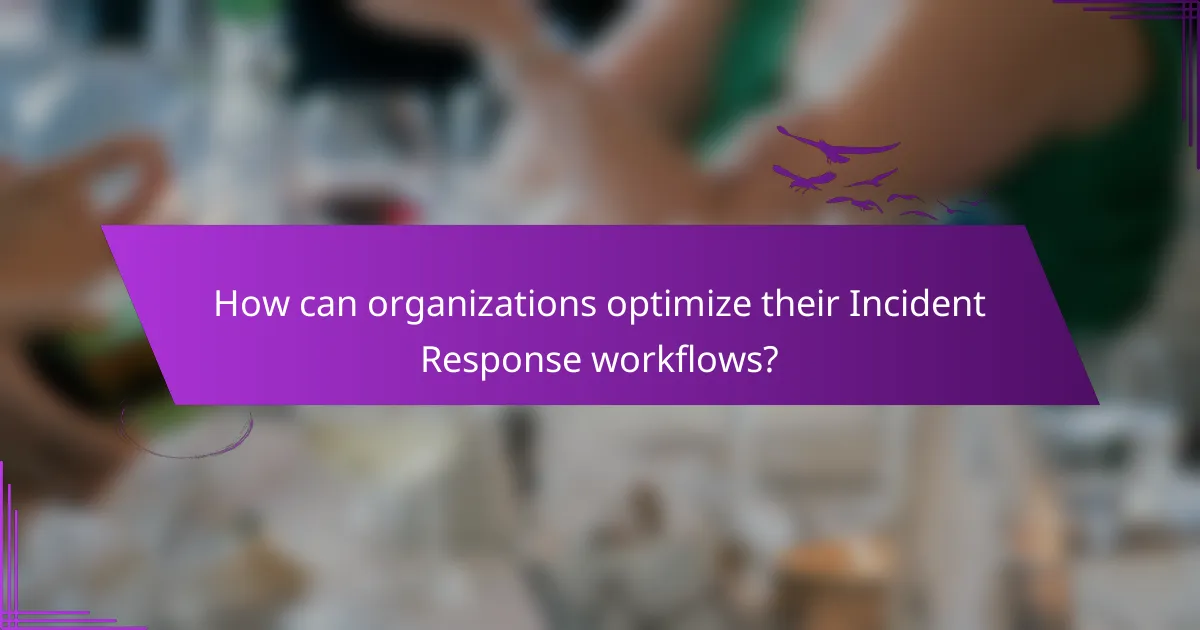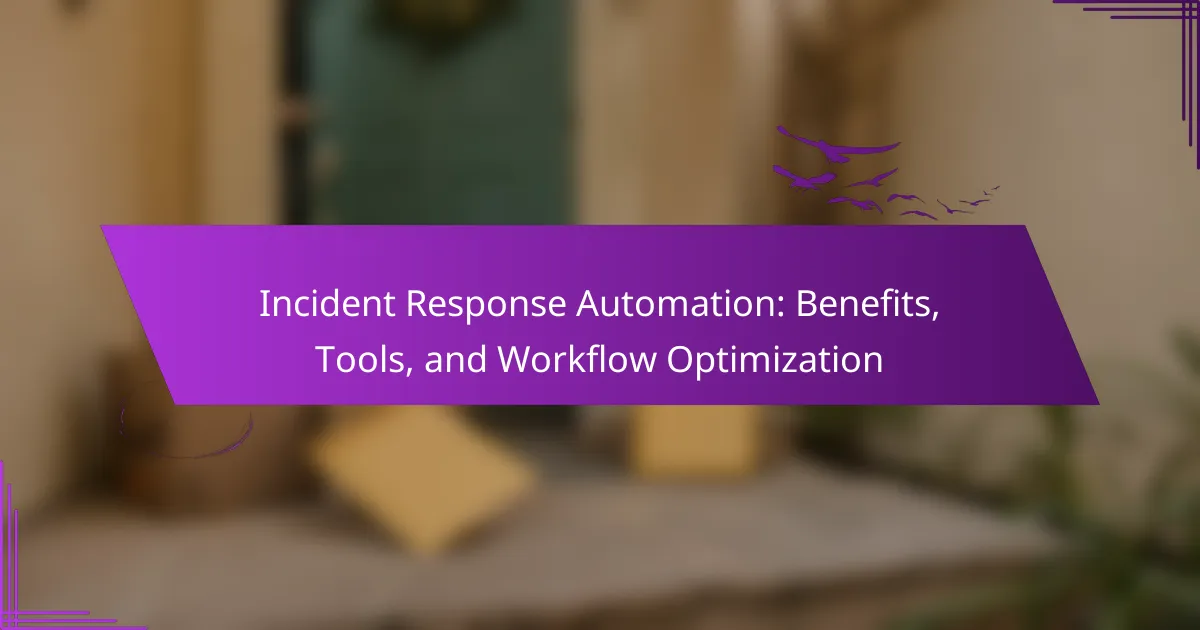
What is Incident Response Automation?
Incident response automation is the use of technology to streamline and manage responses to security incidents. It enables organizations to quickly detect, analyze, and respond to threats with minimal human intervention. Automation tools can execute predefined workflows, reducing response times significantly. For example, automated systems can isolate affected systems or gather forensic data without manual input. This efficiency helps mitigate damage and allows security teams to focus on more complex tasks. According to a study by the Ponemon Institute, organizations that implement automation can reduce incident response time by up to 60%.
How does Incident Response Automation function in cybersecurity?
Incident Response Automation in cybersecurity streamlines the process of responding to security incidents. It utilizes predefined workflows and automated tools to detect, analyze, and remediate threats. Automation reduces the time taken to respond to incidents, minimizing potential damage. Tools like Security Orchestration, Automation and Response (SOAR) platforms are commonly used. These platforms integrate with existing security tools to facilitate automated responses. For example, they can automatically isolate infected systems or block malicious IP addresses. According to a 2021 report by IBM, organizations that automate incident response can reduce the time to identify and contain breaches by up to 80%. This efficiency not only enhances security posture but also frees up cybersecurity teams for more strategic tasks.
What are the key components of Incident Response Automation?
The key components of Incident Response Automation include orchestration, automation, and integration. Orchestration coordinates various tools and processes to streamline incident response. Automation executes predefined actions without human intervention, enhancing speed and efficiency. Integration connects different security tools, enabling seamless data sharing and communication. Together, these components improve incident detection and response times. Studies show that organizations using automation can reduce incident response times by up to 50%.
How do these components interact during an incident?
During an incident, components such as detection systems, response teams, and communication tools interact dynamically. Detection systems identify anomalies and alert response teams. Response teams analyze alerts and determine appropriate actions. Communication tools facilitate real-time updates among team members. Each component relies on the others for effective incident management. For example, if a detection system flags a potential breach, the response team must quickly assess the situation. This collaboration ensures timely and coordinated responses to mitigate threats. Effective interaction among these components leads to reduced incident resolution times and improved overall security posture.
What are the primary benefits of Incident Response Automation?
Incident Response Automation streamlines and enhances the efficiency of incident management. It reduces response times significantly, allowing organizations to address threats more swiftly. Automation minimizes human error by standardizing response procedures. This leads to more consistent and reliable incident handling. Additionally, it frees up security teams to focus on strategic tasks rather than repetitive actions. According to a study by IBM, organizations that implement automation can reduce incident resolution time by up to 80%. This efficiency not only improves security posture but also helps in compliance with regulatory requirements. Overall, Incident Response Automation leads to faster, more accurate, and more efficient incident management.
How does Incident Response Automation improve response times?
Incident Response Automation significantly improves response times by streamlining processes and reducing manual intervention. Automated systems can detect incidents in real-time, allowing for immediate alerts to the response team. This rapid detection minimizes the time between incident occurrence and response initiation. Automation also facilitates predefined response actions that can be executed without human delay. According to a study by the Ponemon Institute, organizations using automation report a 40% reduction in response times. Furthermore, automation reduces the likelihood of human error, which can prolong response efforts. By integrating threat intelligence, automated systems can prioritize incidents based on severity. This prioritization allows teams to focus on critical threats swiftly, enhancing overall efficiency.
What cost savings can organizations achieve through automation?
Organizations can achieve significant cost savings through automation by reducing labor costs and increasing efficiency. Automation minimizes the need for manual intervention, which can lead to lower staffing expenses. For instance, a study by McKinsey found that automation can reduce operational costs by up to 30%. Additionally, automated processes can complete tasks faster than human workers, resulting in time savings that translate into financial benefits. Streamlined workflows also reduce errors, decreasing the costs associated with corrections and rework. Furthermore, organizations can allocate resources more effectively, focusing on strategic initiatives rather than routine tasks. Overall, the integration of automation can lead to substantial long-term savings and improved financial performance.
How does Incident Response Automation enhance incident accuracy?
Incident Response Automation enhances incident accuracy by minimizing human error during incident handling. Automated systems analyze data quickly and consistently. They apply predefined rules to identify and prioritize threats. This reduces the likelihood of oversight or misinterpretation of alerts. Automation also standardizes responses, ensuring uniformity in incident management. According to a study by the Ponemon Institute, organizations using automation reported a 50% reduction in response time. Faster response times contribute to more accurate incident resolution. Thus, Incident Response Automation leads to improved accuracy in identifying and addressing security incidents.

What tools are available for Incident Response Automation?
Tools available for Incident Response Automation include Security Information and Event Management (SIEM) systems, Security Orchestration Automation and Response (SOAR) platforms, and endpoint detection and response (EDR) solutions. SIEM systems aggregate and analyze security data from various sources. SOAR platforms automate incident response workflows and integrate with multiple security tools. EDR solutions monitor endpoints for suspicious activities and facilitate automated responses. These tools enhance the efficiency of incident response by reducing response times and improving threat detection capabilities.
How do these tools integrate with existing security systems?
Incident response automation tools integrate with existing security systems by using APIs and connectors. These integrations allow for seamless data exchange between tools and systems. For example, security information and event management (SIEM) systems can send alerts to automation tools for faster response. Additionally, automation tools can execute predefined actions in response to incidents detected by security systems. This reduces manual intervention and speeds up incident resolution. Research shows that organizations using integrated automation tools experience a 30% reduction in incident response time. Effective integration enhances overall security posture and operational efficiency.
What are the most popular Incident Response Automation tools?
The most popular Incident Response Automation tools include Splunk Phantom, IBM Resilient, and Demisto. Splunk Phantom provides orchestration and automation capabilities for incident response. IBM Resilient offers a comprehensive platform for managing security incidents. Demisto, now part of Palo Alto Networks, combines security orchestration with collaboration features. These tools are widely recognized in the industry for enhancing response efficiency. Their popularity stems from features like customizable workflows and integration with various security products.
How do organizations choose the right tool for their needs?
Organizations choose the right tool by assessing their specific needs and requirements. They begin by identifying the problems they aim to solve. Next, they evaluate the features and functionalities of available tools. Cost-effectiveness is also a critical factor in the selection process. Organizations often compare tools based on user reviews and expert recommendations. Integration capabilities with existing systems are crucial for seamless operation. Additionally, scalability to accommodate future growth is considered. Finally, organizations may conduct trials or demos to ensure usability and effectiveness. These steps help ensure that the chosen tool aligns with their operational goals and enhances incident response capabilities.
What features should organizations look for in Incident Response Automation tools?
Organizations should look for scalability, integration capabilities, and real-time monitoring in Incident Response Automation tools. Scalability ensures that the tool can handle increasing volumes of incidents as the organization grows. Integration capabilities allow seamless connection with existing security tools and systems, enhancing overall efficiency. Real-time monitoring provides immediate alerts and insights into security incidents, enabling swift responses. Additionally, organizations should consider features like automated reporting, playbook customization, and user-friendly interfaces. Automated reporting streamlines documentation processes, while playbook customization allows tailoring responses to specific threats. A user-friendly interface facilitates easier adoption across teams. These features collectively enhance incident response effectiveness and reduce resolution times.
What role does scalability play in tool selection?
Scalability is crucial in tool selection for incident response automation. It determines how well a tool can adapt to increasing workloads or changing demands. A scalable tool can handle larger volumes of incidents without a decline in performance. This ensures that as an organization grows, its incident response capabilities remain effective. For example, a tool that supports scaling can accommodate more users or integrate with additional systems seamlessly. A lack of scalability can lead to bottlenecks and hinder response times during critical incidents. Therefore, evaluating scalability helps ensure long-term effectiveness and efficiency in incident response processes.
How important is user-friendliness in these tools?
User-friendliness is crucial in incident response automation tools. High usability ensures that teams can quickly adapt to the tools. This leads to faster incident resolution and minimizes downtime. According to a study by the Ponemon Institute, organizations with user-friendly tools report a 30% reduction in response time. Additionally, intuitive interfaces reduce training costs and improve team efficiency. When tools are easy to navigate, users are less likely to make errors. This ultimately enhances the overall effectiveness of incident response efforts.

How can organizations optimize their Incident Response workflows?
Organizations can optimize their Incident Response workflows by implementing automation tools and structured processes. Automation reduces manual tasks and accelerates response times. For example, tools like Security Information and Event Management (SIEM) systems can aggregate and analyze security data in real-time. This enables quicker detection of incidents and more efficient prioritization of responses.
Additionally, organizations should establish clear communication protocols among teams. This ensures that everyone is informed and can act swiftly during an incident. Regular training and simulations help teams practice their response strategies. According to a study by the Ponemon Institute, organizations that conduct regular incident response exercises can reduce the average cost of a data breach by 50%.
Furthermore, integrating threat intelligence feeds into workflows enhances the ability to preemptively address potential threats. Continuous monitoring and feedback loops allow for the refinement of response strategies over time. By leveraging these methods, organizations can significantly enhance their Incident Response capabilities.
What steps can be taken to streamline Incident Response processes?
To streamline Incident Response processes, organizations should implement a structured incident response plan. This plan should define roles and responsibilities clearly. Regular training and simulations are essential to prepare the response team. Automation tools can enhance efficiency by handling repetitive tasks. Establishing communication protocols helps ensure timely information sharing. Continuous monitoring and analysis of incidents improve response strategies. Finally, reviewing and updating the response plan regularly keeps it relevant and effective. Each of these steps contributes to a more efficient and effective incident response process.
How can organizations assess their current workflows for improvement?
Organizations can assess their current workflows for improvement by analyzing workflow efficiency and identifying bottlenecks. They can map existing processes to visualize each step and its duration. This mapping helps pinpoint areas where delays occur. Organizations should gather quantitative data on workflow performance metrics. Metrics such as cycle time and error rates provide insight into inefficiencies. Conducting employee surveys can reveal pain points in the workflow. Engaging team members in the assessment fosters a culture of continuous improvement. Benchmarking against industry standards can highlight gaps in performance. Regular reviews of workflows ensure ongoing optimization and adaptability to changing needs.
What best practices should be implemented for effective workflow optimization?
Implementing best practices for effective workflow optimization involves several key strategies. First, clearly define roles and responsibilities within the team. This clarity helps reduce confusion and improves accountability. Second, utilize automation tools to streamline repetitive tasks. Automation can significantly reduce the time spent on manual processes. Third, regularly review and analyze workflows for inefficiencies. Continuous assessment allows teams to identify bottlenecks and make necessary adjustments. Fourth, prioritize communication and collaboration among team members. Effective communication enhances information sharing and decision-making. Fifth, establish measurable goals and KPIs to track progress. Metrics provide insight into workflow performance and areas for improvement. Lastly, invest in training and development for team members. Skilled personnel can adapt to new tools and processes more effectively. These practices collectively contribute to a more efficient and responsive workflow.
What challenges may arise during the implementation of Incident Response Automation?
Challenges during the implementation of Incident Response Automation include integration difficulties with existing systems. Organizations may face compatibility issues between automation tools and legacy systems. Additionally, there may be a lack of skilled personnel to manage and operate automation solutions. This skill gap can hinder effective deployment and utilization. Furthermore, organizations might encounter resistance to change from staff accustomed to traditional incident response methods. This cultural barrier can slow down the adoption process. Data quality issues can also arise, as automation relies heavily on accurate and reliable data inputs. Without proper data governance, automation may produce misleading results. Lastly, the complexity of configuring automation tools can lead to misconfigurations, increasing security risks instead of mitigating them.
How can organizations overcome resistance to automation?
Organizations can overcome resistance to automation by fostering a culture of acceptance and understanding. They should involve employees in the automation process from the beginning. Providing training helps employees feel more competent and confident in using new technologies. Clear communication about the benefits of automation can alleviate fears. Demonstrating how automation can reduce repetitive tasks increases buy-in. Sharing success stories from other organizations can inspire confidence. Leadership support is crucial in modeling positive attitudes toward automation. Regular feedback loops allow employees to express concerns and contribute to improvements.
What are common pitfalls to avoid in the automation process?
Common pitfalls to avoid in the automation process include lack of clear objectives and inadequate testing. Without clear objectives, automation efforts can become misaligned with business goals. Inadequate testing can lead to unexpected failures during implementation. Failing to involve relevant stakeholders can result in oversights and miscommunication. Ignoring the need for continuous monitoring can cause automated processes to become outdated. Additionally, underestimating the complexity of the systems involved can lead to integration issues. Not providing proper training for users can hinder adoption and effectiveness. Finally, neglecting to establish a rollback plan can complicate recovery from automation failures.
What are some practical tips for successful Incident Response Automation?
Successful incident response automation requires clear processes and well-defined workflows. Start by identifying and categorizing potential incidents. This helps in prioritizing responses based on severity. Implement a centralized logging system to gather data from various sources. This ensures comprehensive visibility into incidents. Use predefined playbooks for common incident types. This standardizes responses and reduces reaction time. Regularly test and update automation scripts to ensure they function correctly. Continuous improvement is key to adapting to new threats. Train your team on the automation tools and processes. This enhances their ability to respond effectively.
Incident Response Automation is the strategic use of technology to enhance the efficiency and effectiveness of managing security incidents. This article provides an in-depth exploration of its key components, including orchestration, automation, and integration, as well as the tools available, such as SIEM and SOAR platforms. It highlights the significant benefits of automation, including reduced response times, minimized human error, and potential cost savings. Additionally, the article outlines best practices for optimizing incident response workflows and addresses common challenges organizations may face during implementation.
